2003 PONTIAC BONNEVILLE ECU
[x] Cancel search: ECUPage 6 of 418
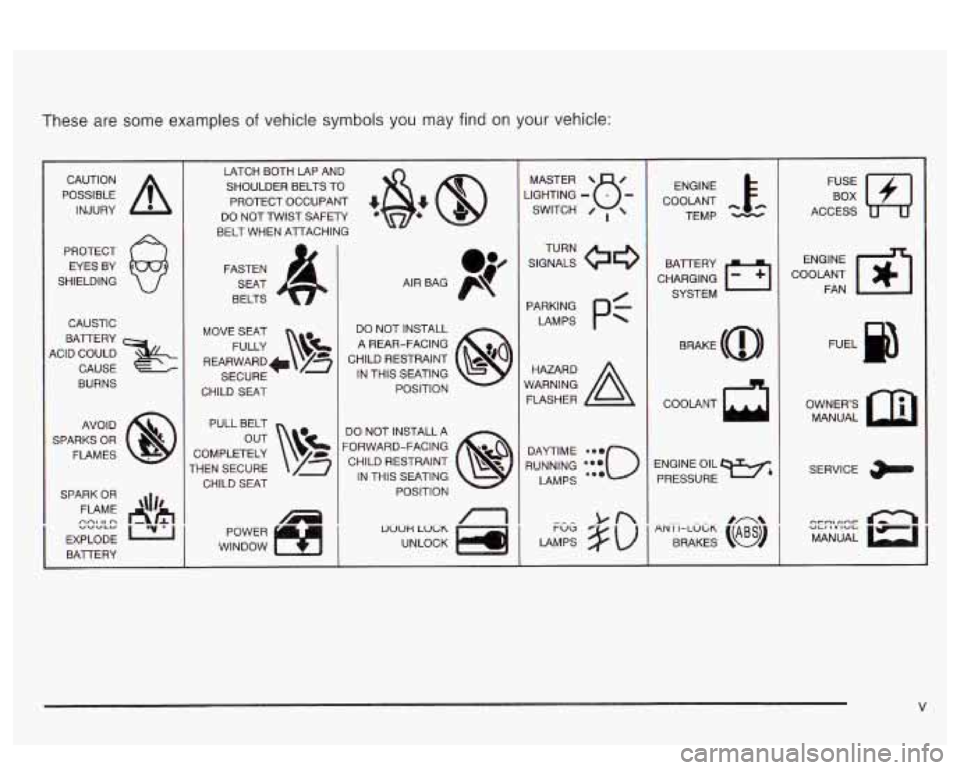
These are some examples of vehicle symbols you may find on your vehicle:
POSSIBLE A
CAUTION
INJURY
PROTECT EYES BY
SHIELDING
CAUSTIC
KID COULD
&
BATTERY
CAUSE
BURNS
AVO ID
SPARKS OR
FLAMES
SPARK OR
FLAME '\I/'
EXPLODE L22
BAlTERY
nnl It n "VVLY
1
LATCH BOTH LAP AND
SHOULDER BELTS TO
PROTECT OCCUPANT
*@? @
DO NOT TWIST SAFETY
BELT WHEN ATTACHING
FASTEN
SEAT
BELTS
MOVE SEAT
FULLY
\!&
REARWARD+ /z
SECURE
CHILD
SEAT
PULL BELT
COMPLETELY
THEN SECURE CHILD SEAT
WINDOW POWER
1
I
f
1
DO NOT INSTALL
A REAR-FACING
CHILD RESTRAINT IN THIS SEATING
POSITION
DO NOT INSTALL A
'ORWARD-FACING CHILD RESTRAINT
IN THIS SEATING
POSITION
uoon LOCK
UNLOCK
/17
I
1
JGHTING - MASTER SWITCH 8- 0 ,
RUNNING ***o
DAYTIME e-.
LAMPS ...
ENGINE
COOLANT TEMP
CHARGING
L-1
BAlTERY SYSTEM
BRAKE
(@)
COOLANT
ENGINE OIL
PRESSURE
w4
l.fJ
ACCESS
ENGINE
COOLANT FAN
OWNERS MANUAL
SERVICE
Page 8 of 418
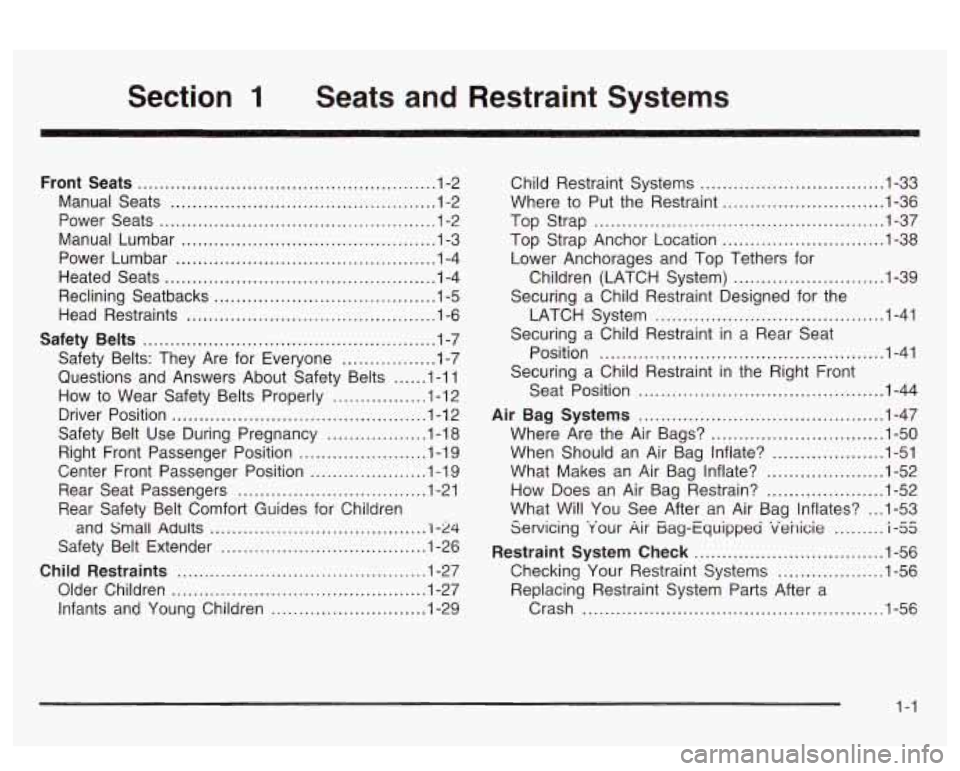
Section 1 Seats and Restraint Systems
Front Seats ................................................... 1-2
Manual Seats
................................................ 1-2
Power Seats
.................................................. 1-2
Manual Lumbar
.............................................. 1-3
Power Lumbar
............................................... 1-4
Heated Seats
................................................. 1-4
Reclining Seatbacks
........................................ 1-5
Head Restraints
............................................. 1-6
Safety Belts ..................................................... 1-7
Safety Belts: They Are for Everyone
................. 1-7
Questions and Answers About Safety Belts
...... 1-1 1
How to Wear Safety Belts Properly
................. 1-12
Driver Position
.............................................. 1-1 2
Safety Belt Use During Pregnancy
.................. 1-18
Right Front Passenger Position
....................... 1-1 9
Center Front Passenger Position
..................... 1-1 9
Rear Seat Passengers
.................................. 1-21
Safety Belt Extender
..................................... 1-26
Child Restraints ............................................. 1-27
Older Children
.............................................. 1-27
Infants and Young Children
............................ 1-29
Rear Safety Belt Comfort
Guides for Children
and Small Adults
....................................... i -24
Child Restraint Systems ................................. 1-33
Top Strap
.................................................... 1-37
Top Strap Anchor Location
............................. 1-38
Children (LATCH System)
........................... 1-39
LATCH System
......................................... 1-41
Position
................................................... 1-41
Seat Position
............................................ 1-44
Air Bag Systems ............................................ 1-47
Where Are the Air Bags?
............................... 1-50
What Makes an Air Bag Inflate?
..................... 1-52
How Does an Air Bag Restrain?
..................... 1-52
What Will You See After an Air Bag Inflates?
... 1-53
Restraint System Check .................................. 1-56
Checking Your Restraint Systems
................... 1-56
Crash
...................................................... 1-56
Where
to Put the Restraint
............................. 1-36
Lower Anchorages and Top Tethers for
Securing a Child Restraint Designed for the
Securing a Child Restraint in a Rear Seat
Securing a Child Restraint in the Right Front
When Should an Air Bag Inflate?
.................... 1-51
Servicing Your Air Bag-Equipped venicie
1-33 2 -c .........
Replacing Restraint System Parts After a
1-1
Page 20 of 418
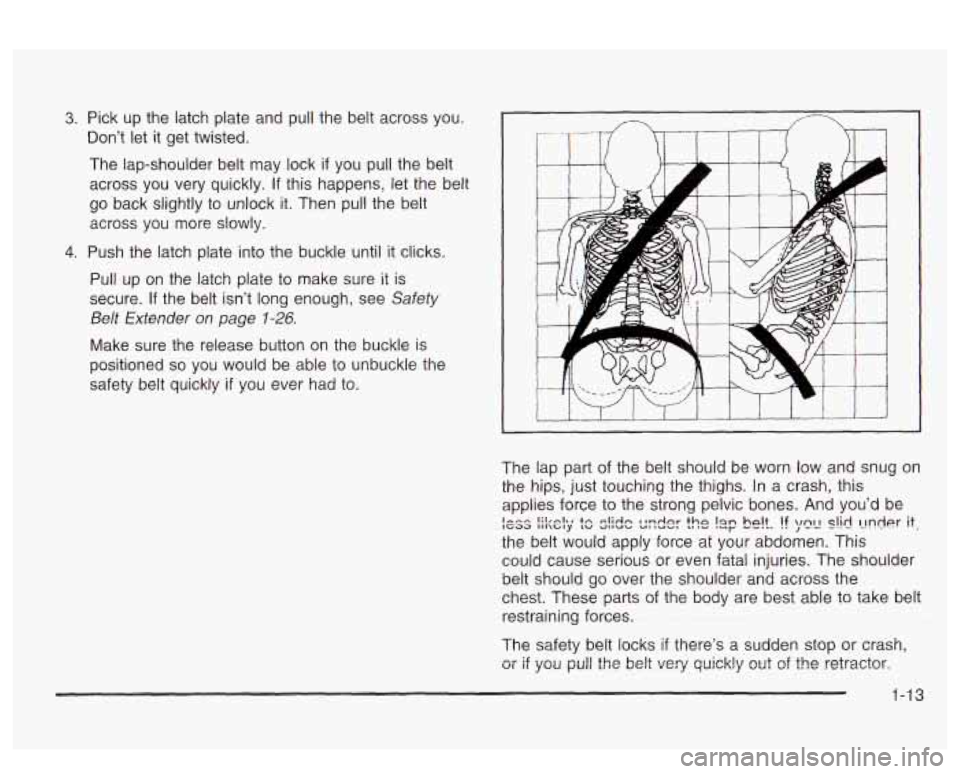
3. Pick up the latch plate and pull the belt across you.
Don’t let it get twisted.
The lap-shoulder belt may lock if
you pull the belt
across you very quickly.
If this happens, let the belt
go back slightly to unlock it. Then pull the belt
across
you more slowly.
4. Push the latch plate into the buckle until it clicks.
Pull up on the latch plate
to make sure it is
secure.
If the belt isn’t long enough, see Safety
Belt Extender on page 1-26.
Make sure the release button on the buckle is
positioned
so you would be able to unbuckle the
safety belt quickly
if you ever had to.
The lap part of the belt should be worn low and
snug on
the hips, just touching the thighs. In a crash, this
applies force to the strong pelvic bones. And you’d be
the belt would apply force at your abdomen. This
could cause serious or even fatal injuries. The shoulder
belt should go over the shoulder and across the
chest. These parts of the body are best able
to take belt
restratnmgforces.---
~~~~~ ~~~ ~ ~ ~~ ~~.
The safety belt locks if there’s a sudden stop or crash,
or
if you pull the belt very quickly out of the retractor.
I--- IGa3 ~;L,.I~~ IlRCFly +n Iw al1UQ nlidn u&luvk 1 lndor tho LI IV Ian sur hnlt wwa.. !f yc~ slid L!nr&r it,
..
1-13
Page 29 of 418
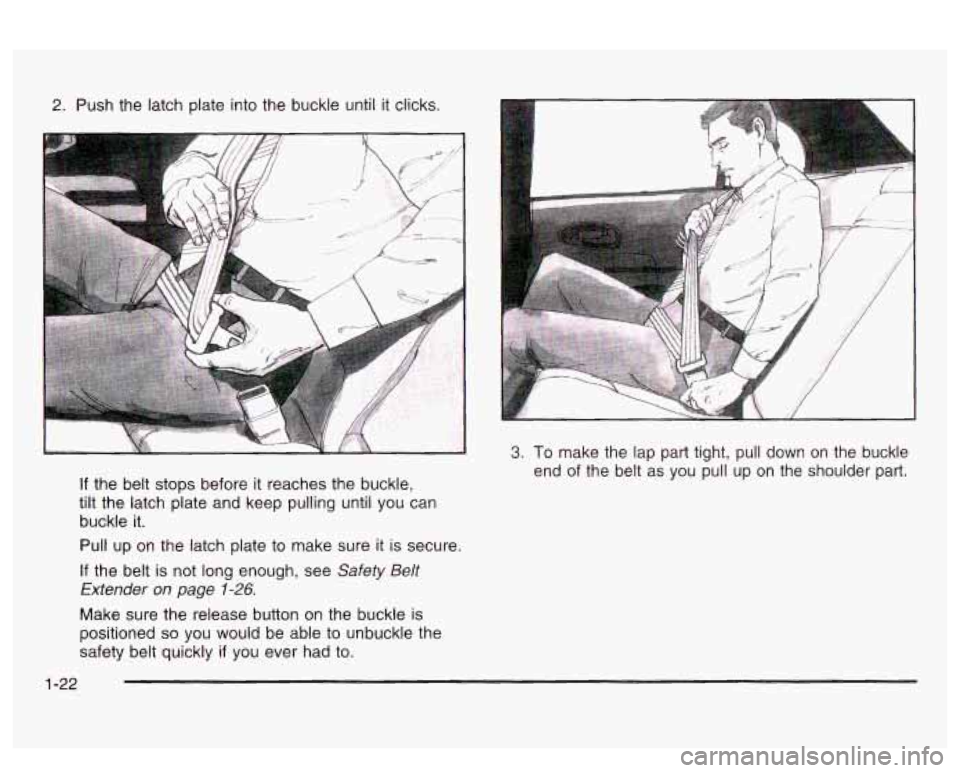
2. Push the latch plate into the buckle until it clicks.
If the belt stops before it reaches the buckle,
tilt the latch plate and keep pulling until you can
buckle
it.
Pull up on the latch plate to make sure it is secure.
If the belt is not long enough, see Safety Belt
Extender on page
1-26.
Make sure the release button on the buckle is
positioned
so you would be able to unbuckle the
safety belt quickly
if you ever had to.
3. To make the lap part tight, pull down on the buckle
end of the belt as you pull up on the shoulder part.
1-22
Page 37 of 418
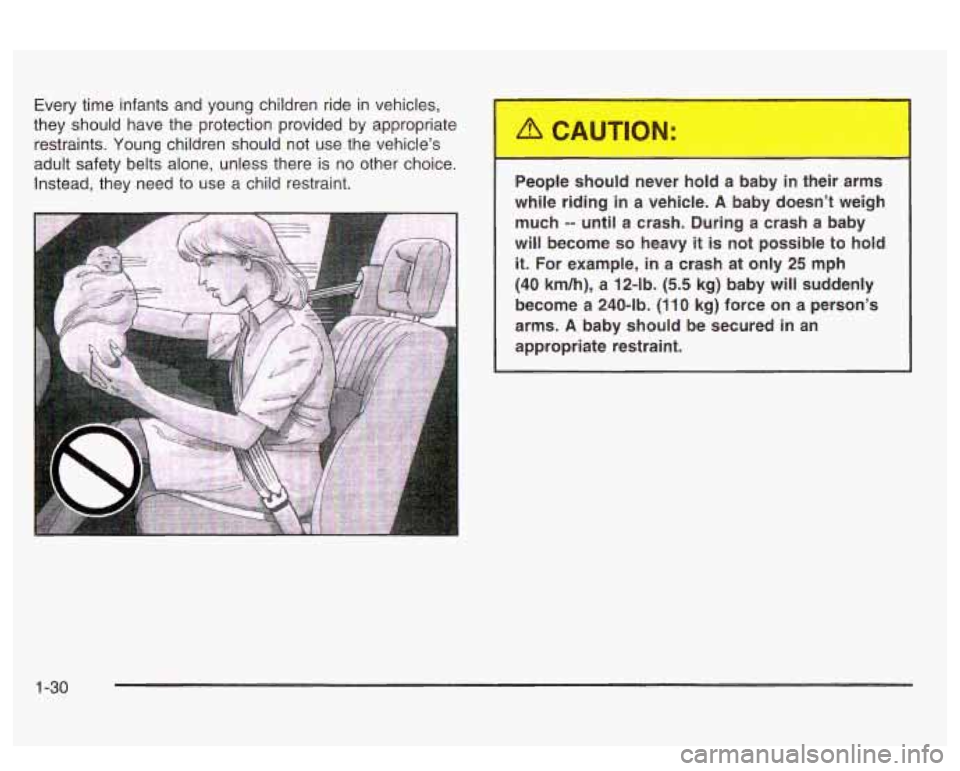
Every time infants and young children ride in vehicles,
they should have the protection provided by appropriate restraints. Young children should not use the vehicle’s
adult safety belts alone, unless there is no other choice.
Instead, they need to use a child restraint. People should
never hold a bab n their arms
while riding
in a vehicle. A baby doesn’t weigh
much
-- until a crash. During a crash a baby
~ will become so heavy it is not possible to hold
~ it. For example, in a crash at only 25 mph
~ (40 km/h), a 12-lb. (5.5 kg) baby will suddenly
~ become a 240-lb. (110 kg) force on a person’s
arms.
A baby should be secured in an
appropriate restraint.
1-30
Page 39 of 418
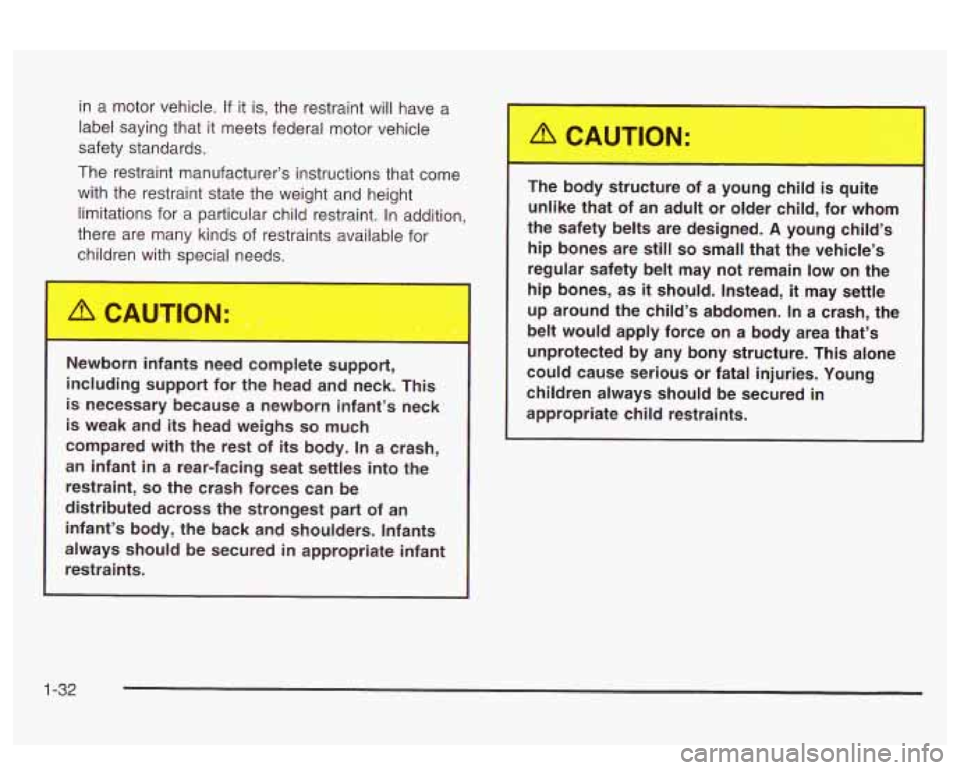
in a motor vehicle. If it is, the restraint will have a
label saying that it meets federal motor vehicle
safety standards.
The restraint manufacturer’s instructions that come
with the restraint state the weight and height
limitations for a particular child restraint.
In addition,
there are many kinds of restraints available for
children with special needs.
Newborn infants need complete support,
including support for the head and neck. This
is necessary because a newborn infant’s neck
is weak and its head weighs
so much
compared with the rest of
its body. In a crash,
an infant
in a rear-facing seat settles into the
restraint,
so the crash forces can be
distributed across the strongest part of an
infant’s body, the back and shoulders. Infants
always should be secured
in appropriate infant
restraints. The
body structure of
_. loung ck---J is quite
unlike that of an adult or older child, for whom
the safety belts are designed. A young child’s
hip bones are still
so small that the vehicle’s
regular safety belt may not remain
low on the
hip bones, as
it should. Instead, it may settle
up around the child’s abdomen. In a crash, the
belt would apply force on a body area that’s
unprotected by any bony structure. This alone
could cause serious or fatal injuries. Young
children always should be secured in
appropriate child restraints.
1-32
Page 42 of 418
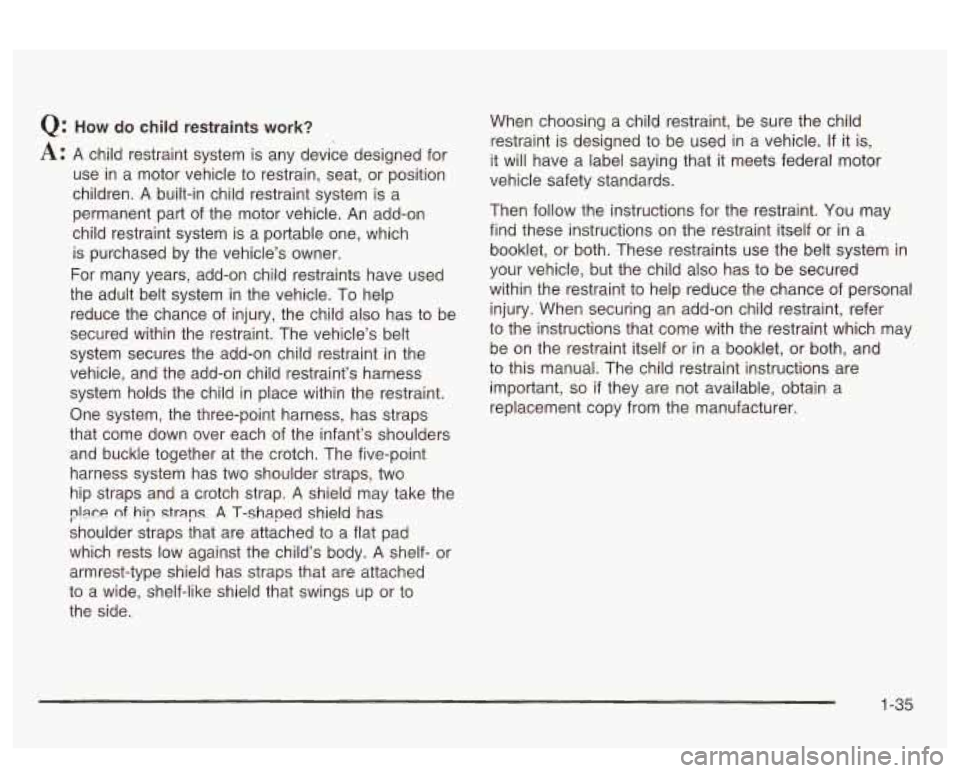
Q: How do child restraints work?
A: A child restraint system is any device designed for
use in a motor vehicle to restrain, seat, or position
children.
A built-in child restraint system is a
permanent part of the motor vehicle. An add-on
child restraint system is a portable one, which
is purchased by the vehicle’s owner.
For many years, add-on child restraints have used
the adult belt system in the vehicle. To help
reduce the chance of injury, the child also has to be
secured within the restraint. The vehicle’s belt
system secures the add-on child restraint in the
vehicle, and the add-on child restraint’s harness
system holds the child in place within the restraint.
One system, the three-point harness, has straps
that come down over each of the infant’s shoulders
and buckle together at the crotch. The five-point
harness system has two shoulder straps, two
hip straps and a crotch strap.
A shield may take the
p!aw of hi? straps. A T-shaped shield has
shoulder straps that are attached to a flat pad
which rests low against the child’s body.
A shelf- or
armrest-type shield has straps that are attached
to a wide, shelf-like shield that swings up or to
~ ~~~ ~ the side. ~~~~~~~~~~~~~~
~~~ ~ ~
When choosing a child restraint, be sure the child
restraint is designed to be used in a vehicle.
If it is,
it will have a label saying that it meets federal motor
vehicle safety standards.
Then follow the instructions for the restraint. You may
find these instructions on the restraint itself or in a
booklet, or both. These restraints use the belt system in
your vehicle, but the child also has to be secured
within the restraint to help reduce the chance of personal
injury. When securing an add-on child restraint, refer
to the instructions that come with the restraint which may
be on the restraint itself or in a booklet, or both, and
to this manual. The child restraint instructions are
important,
so if they are not available, obtain a
replacement copy from the manufacturer.
1-35
Page 43 of 418
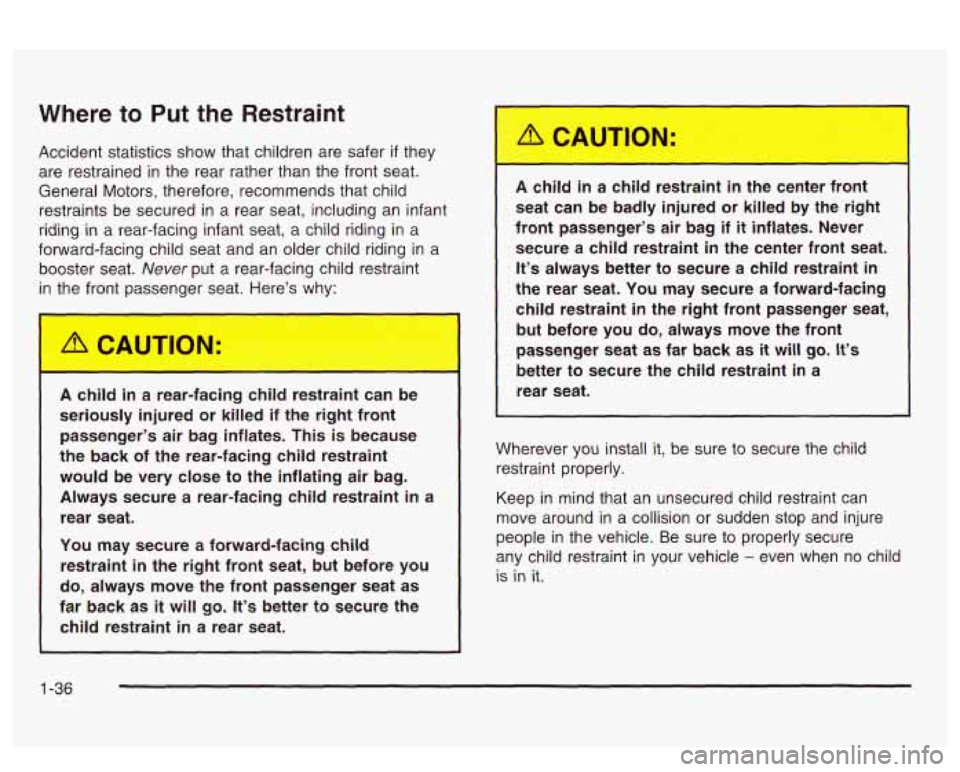
Where to Put the Restraint
Accident statistics show that children are safer if they
are restrained in the rear rather than the front seat.
General Motors, therefore, recommends that child
restraints be secured in
a rear seat, including an infant
riding in a rear-facing infant seat, a child riding in a
forward-facing child seat and an older child riding in a
booster seat.
Never put a rear-facing child restraint
in the front passenger seat. Here’s why:
CAUT’3N:
A child in a rear-facing child restraint can be
seriously injured or killed
if the right front
passenger’s air bag inflates. This
is because
the back of the rear-facing child restraint
would be very close to the inflating air bag.
Always secure a rear-facing child restraint
in a
rear seat.
You may secure a forward-facing child restraint
in the right front seat, but before you
do, always move the front passenger seat as
far back
as it will go. It’s better to secure the
child restraint
in a rear seat.
A child in a child restraint in the center front
seat can be badly injured or killed by the right
front passenger’s air bag if
it inflates. Never
secure a child restraint in the center front seat.
It’s always better to secure a child restraint in
the rear seat. You may secure a forward-facing
child restraint
in the right front passenger seat,
but before you do, always move the front
passenger seat as far back as
it will go. It’s
better to secure the child restraint in a
rear seat.
Wherever you install it, be sure to secure the child
restraint properly.
Keep in mind that an unsecured child restraint can
move around in a collision or sudden stop and injure
people in the vehicle. Be sure to properly secure
any child restraint in your vehicle
- even when no child
is in it.
1-36